Chapter 28.64
POST-CONSTRUCTION STORMWATER MANAGEMENT
Sections:
28.64.020 Standards for best management practices (BMPs) – Minimum structural BMPs requirements.
28.64.030 Standards for best management practices (BMPs) – Aesthetic requirements.
28.64.040 Standards for best management practices (BMPs) – Proprietary BMPs.
28.64.050 Standards for best management practices (BMPs) – Considerations in BMPs selection.
28.64.070 Final drainage report.
28.64.080 Water quality capture volume.
28.64.090 Directly connected impervious area.
28.64.100 Water quality capture volume.
28.64.110 Nonstructural BMPs – General information.
28.64.120 Nonstructural BMPs – Spill prevention and response.
28.64.130 Inspection and enforcement.
28.64.140 BMPs for industrial and commercial activities.
28.64.150 Industrial and commercial activities.
28.64.160 Best management practices.
28.64.010 Introduction.
All persons engaged in new development and redevelopment of property that disturbs 1.0 acres or more shall implement post-construction BMPs to control the discharge of pollutants after construction is completed, in accordance with the provisions of this manual. Post-construction BMPs, which includes both structural and nonstructural measures, shall be identified in the final drainage report (see GJMC 28.12.060 through 28.12.100, final drainage report). For requirements during construction, see Chapter 28.60 GJMC, Construction Site Stormwater Runoff Control.
(Res. 40-08 (§ 1601), 3-19-08)
28.64.020 Standards for best management practices (BMPs) – Minimum structural BMPs requirements.
BMPs for significant development and redevelopment capture and detain stormwater in best management practices, called volume capture devices. These BMPs are designed to capture and temporarily detain a large percentage of runoff events and runoff volumes then release the runoff over a six- to 40-hour period, which allows sufficient time for settling of pollutants. Volume capture BMPs are widely used by communities throughout the United States and are considered a standard of practice.
The following BMPs meet the minimum water quality capture volume (WQCV) requirements for on-site or regional stormwater quality facilities:
Figure 28.64.020(a), Porous Pavement Detention (with under-drain only);
Figure 28.64.020(b), Porous Landscape Detention (with under-drain only);
Figure 28.64.020(c), Extended Detention Basin;
Figure 28.64.020(d), Sand Filter Extended Detention Basin;
Figure 28.64.020(e), Constructed Wetland Basin;
Figure 28.64.020(f), Retention Basin;
Figure 28.64.020(g), Grass Swale.
Examples of these BMPs can be found in:
(a) Urban Drainage and Flood Control District (UDFCD) 1999. Urban Storm Drainage Criteria Manual (USDCM), Volume 3 – Best Management Practices. This document is available at:
http://www.udfcd.org/usdcm/vol3.htm.
(b) Water Environment Federation (WEF) and American Society of Civil Engineers (ASCE) 1998. Urban Runoff Quality Management. WEF Manual No. 23, ASCE Manual No. 87.
(c) EPA 2002. Consideration in the Design of Treatment Best Management Practices (BMP) to Improve Water Quality. EPA 600 R-03/103. This document is available in .pdf form at the following website:
http://www.epa.gov/ORD/NRMRL/pubs/600r03103/600r03103chp5.pdf
Portions of the USDCM Volume 3 that are required to design an extended detention basin to include water quality requirements are in Chapter 28.80 GJMC. Each designer should note that all UDFCD documents are updated continuously, and it is the designer’s responsibility to check for these updates to ensure use of the most up-to-date data. Each designer should also note that some equations in this manual have been modified from those in Volume 3 to be specific to Mesa County. Equations in this manual shall govern.
Use of alternate BMPs not specified above is subject to approval by the local jurisdiction. Figure 28.64.020(h) offers a schematic for determining the best BMP options for individual sites.
When new development is served by a regional stormwater quality facility designed in accordance with this chapter and stormwater from the development is discharged to an open conveyance system before reaching the regional facility, on-site BMPs must also be provided. If the new development discharges to the regional stormwater quality facility through a storm drain, then this additional requirement does not apply.
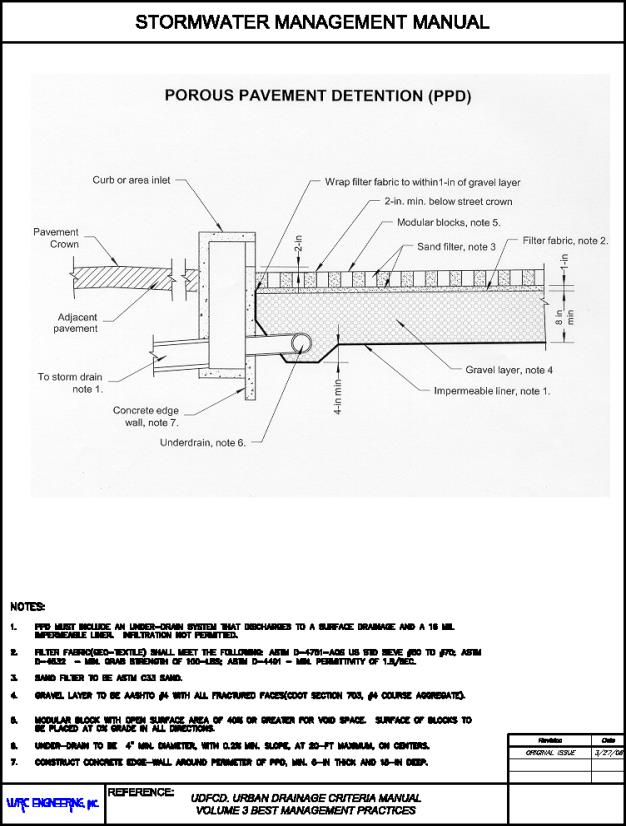
FIGURE 28.64.020(a)
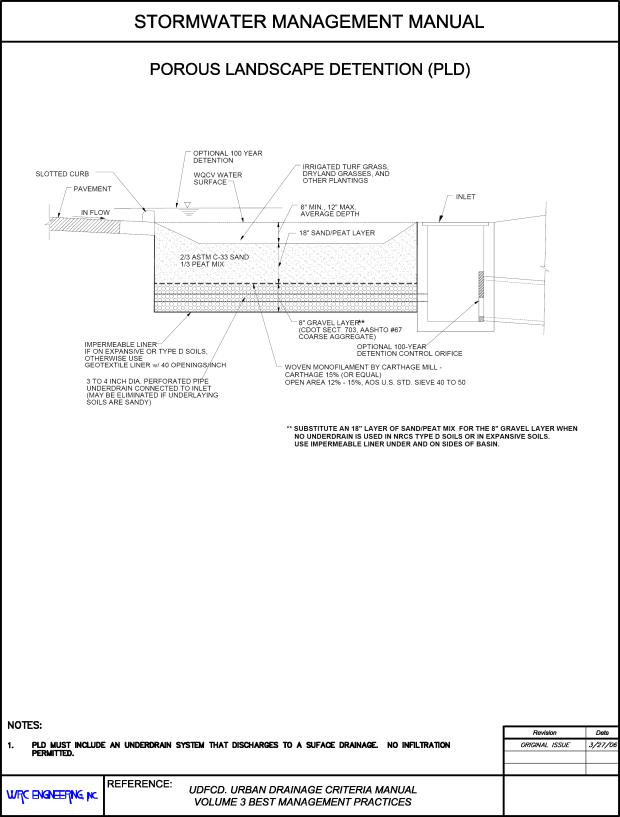
FIGURE 28.64.020(b)
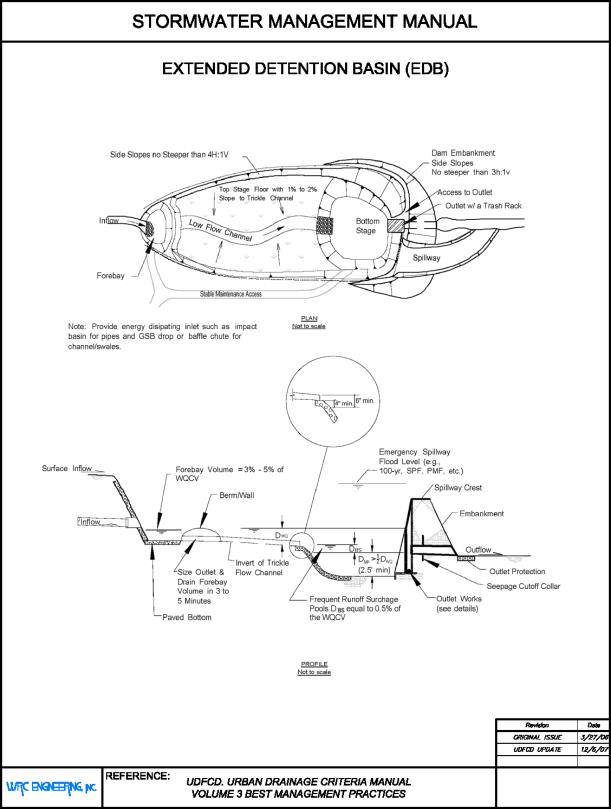
FIGURE 28.64.020(c)
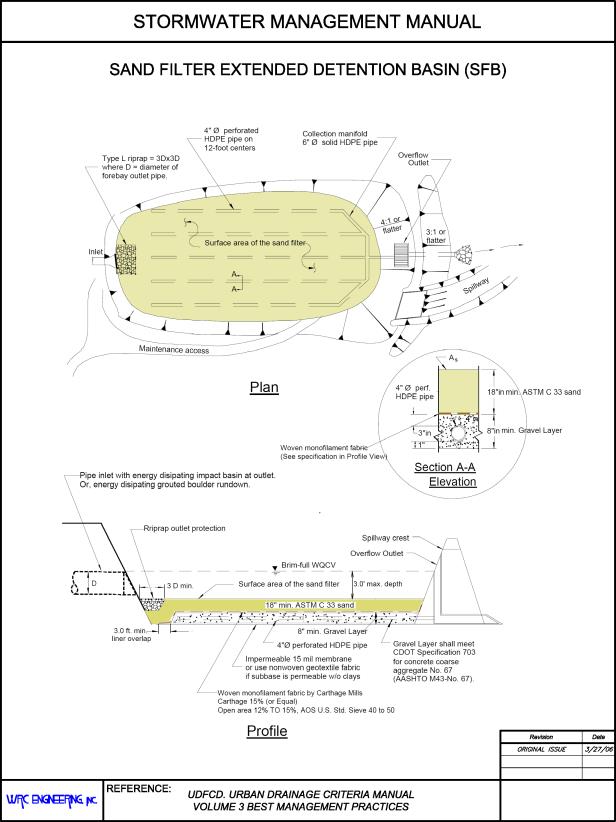
FIGURE 28.64.020(d)
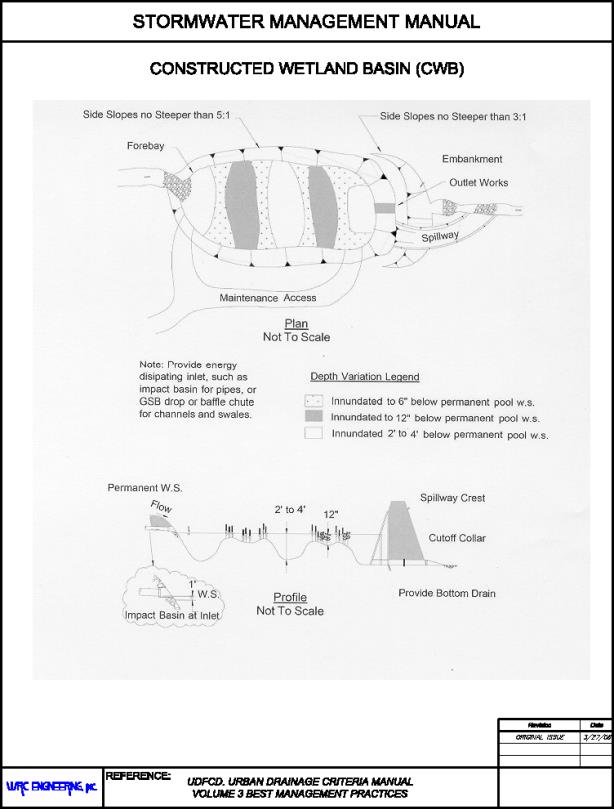
FIGURE 28.64.020(e)
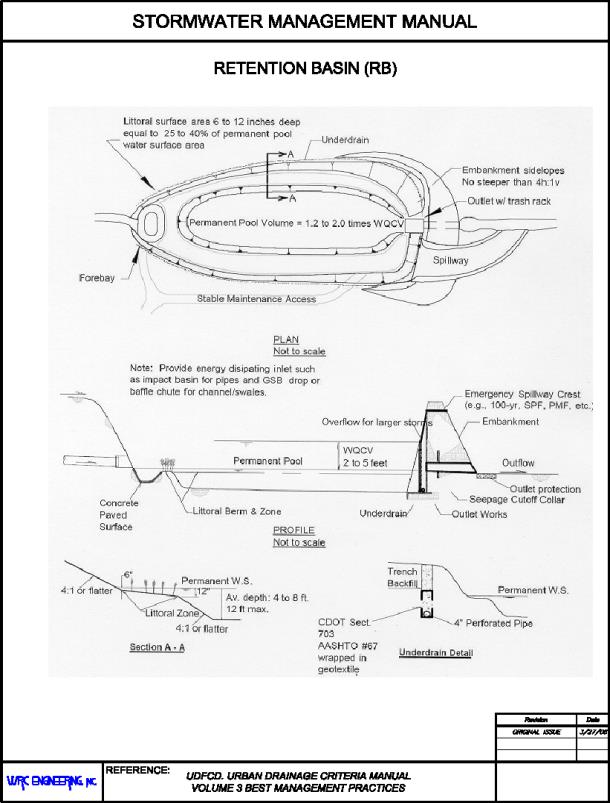
FIGURE 28.64.020(f)
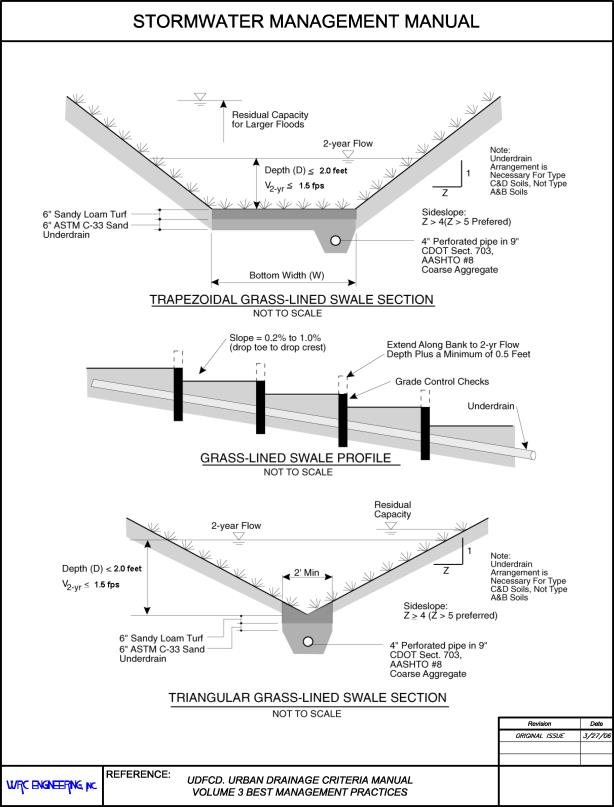
FIGURE 28.64.020(g)
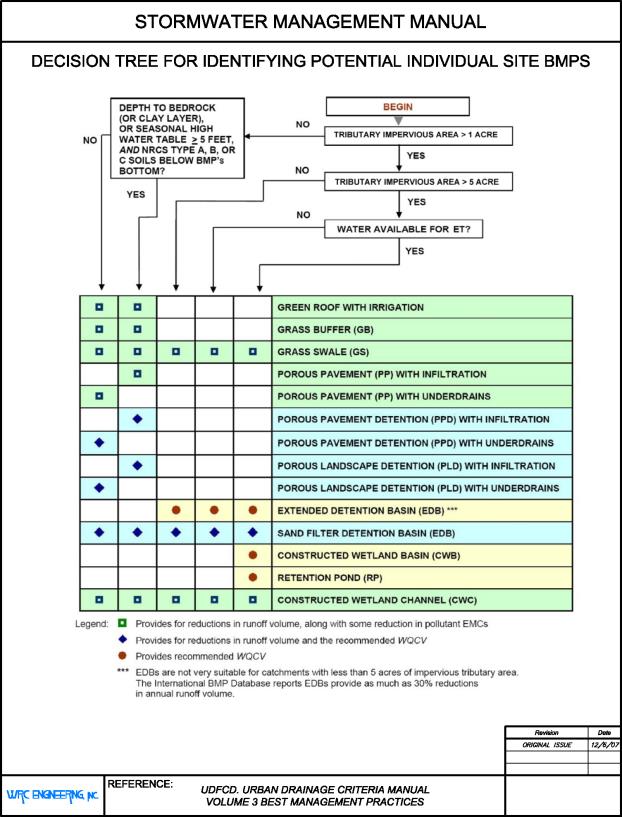
FIGURE 28.64.020(h)
(Res. 40-08 (§ 1602.1), 3-19-08)
28.64.030 Standards for best management practices (BMPs) – Aesthetic requirements.
When storm runoff will be treated by an extended detention basin (dry), a retention pond with a permanent pool (wet), or constructed wetlands, the facility shall be designed with the intent of improving appearance in accordance with requirements under Chapter 28.56 GJMC, Detention and Retention.
(Res. 40-08 (§ 1602.2), 3-19-08)
28.64.040 Standards for best management practices (BMPs) – Proprietary BMPs.
Proprietary systems which meet the requirements of this chapter and have continued inspection/operation and maintenance guarantees in place are allowed provided:
(a) Clear evidence must be provided why WQCV cannot be provided on the ground surface using volume-capture BMPs, and why the use of a subsurface proprietary device is the best choice for the site, considering factors such as initial installation, maintenance, and ability to assure long-term function.
(b) Proprietary BMPs are limited to commercial, new development and redevelopment sites with an area less than five acres tributary to the proprietary BMP. If greater than five acres, a variance or deviation may be requested as described in GJMC 28.08.070.
(c) The proprietary device(s) must provide volume control based on a drain time of no less than six hours or be a supplement to other BMPs which meet these requirements.
(d) A binding, long-term inspection/operation and maintenance plan, including monitoring and reporting, and demonstration of adequate funding for such maintenance, must be provided.
(Res. 40-08 (§ 1602.3), 3-19-08)
28.64.050 Standards for best management practices (BMPs) – Considerations in BMPs selection.
Because of unique conditions in Mesa County, there are important considerations in the selection and design of BMPs. For example:
(a) Vegetation. Vegetation for stabilization is preferred over rock or other hardscape. Native vegetation and grasses that require little water will satisfy this requirement. However, BMPs that rely on vegetation that requires more water than nature provides must include a supplemental irrigation source to maintain adequate plant growth. BMPs such as grass swales and buffers can be supplemented through potable sources and landscape irrigation systems. However, wetlands, wetland ponds, and extended detention basins also require supplemental water sources that include watershed runoff and/or larger scale, irrigation-water sources to maintain vegetation.
(b) Infiltration. Due to the nature of the soils in Mesa County, BMPs that rely specifically on infiltration into the groundwater are discouraged, since some pollutants in the soils can also be leached into the groundwater and eventually to surface waters. However, specific requirements for some BMPs, such as wet-ponds, wetlands, and filtration systems which may result in infiltration, have been modified to require a liner and collection system to minimize or prevent infiltration.
(c) Maintenance Agreement and Guarantee. All drainage and water quality facilities must be designed to facilitate maintenance (see GJMC 28.16.120, Drainage facilities maintenance) and maintenance agreements shall be entered into between a landowner and the local jurisdiction.
Additional guidance on design, site selection, maintenance and other considerations can be found in:
(1) Urban Drainage and Flood Control District (UDFCD) 1999. Urban Storm Drainage Criteria Manual, Volume 3 – Best Management Practices. This document is available in .pdf form at the following website:
http://www.udfcd.org/usdcm/vol3.htm.
(2) City and County of Denver 2004. Water Quality Management Plan 2004. This document is available in .pdf form at the following website:
http://www.denvergov.org/WMDWaterQuality/77516706template3jump.asp
See Chapter 6 Stormwater Quality BMP Implementation Guidelines, Part 4 – BMP Fact sheets.
(Res. 40-08 (§ 1602.4), 3-19-08)
28.64.060 Standards for best management practices (BMPs) – Local modifications to minimum structural BMPs.
(a) Structural BMPs which typically employ micro-pools, namely extended detention basins, may be modified to omit the micro-pool should the local jurisdiction be concerned about negative side effects. Micro-pools were initially added to the standard design for extended detention basins because:
(1) They seemed to develop whether or not they were intended; and
(2) Some data suggested pollutant removal, particularly of nutrients, would improve.
(b) However, the West Nile Virus outbreak in 2003, several outbreaks of algae growth during the drought of 2002, and the increased operation and maintenance requirements that come with micro-pools prompted many communities to forgo their use completely. Given the very dry climate of Mesa County, micro-pools may be considered an optional feature of the extended detention basin (EDB) without compromising the standard of practice for stormwater quality control.
(c) The use of a micro-pool may be considered more appropriate when the:
(1) EDB has a more reliable source of water than solely stormwater runoff;
(2) EDB serves an area greater than 160 acres; and
(3) Permanent pool can be maintained as an aesthetic feature rather than a nuisance.
(Res. 40-08 (§ 1602.5), 3-19-08)
28.64.070 Final drainage report.
A final drainage report shall be prepared which includes a narrative, calculations and drawings showing location and sizes of permanent BMPs used to control the discharge of pollutants to the MS4 system after construction. Requirements for a final drainage report are described in Chapter 28.12 GJMC, Drainage Planning Submittal Requirements.
(Res. 40-08 (§ 1603), 3-19-08)
28.64.080 Water quality capture volume.
Water quality capture volume (WQCV) requirements for structural BMPs can be determined using the following sources. For this manual, equations developed by the UDFCD were used and adjusted for the Mesa County area.
(a) Urban Drainage and Flood Control District (UDFCD) 2002. Urban Storm Drainage Criteria Manual, Volume 3 – Best Management Practices. This document can be obtained in .pdf form at the following website:
http://www.udfcd.org/usdcm/vol3.htm
(b) EPA 2002. Consideration in the Design of Treatment Best Management Practices (BMP) to Improve Water Quality. EPA 600 R-03/103. This document can be obtained in .pdf form at the following website:
http://www.epa.gov/ORD/NRMRL/pubs/600r03103/600r03103chp5.pdf
(c) Water Environment Federation (WEF) and American Society of Civil Engineers (ASCE) 1998. Urban Runoff Quality Management. WEF Manual No. 23, ASCE Manual No. 87.
(Res. 40-08 (§ 1604), 3-19-08)
28.64.090 Directly connected impervious area.
The procedures described in Chapter 28.24 GJMC, Rainfall, and in Chapter 28.28 GJMC, Storm Runoff, are intended for the design of drainages and flood control facilities that prevent damage to property and help protect human life. These procedures show that the depth of rainfall produced from a design storm can vary with location and that runoff is a function of total imperviousness.
Post-construction BMPs focus more on the smaller events that deliver frequent flow pulses and pollutant loads to receiving waters. The runoff volume for smaller events is especially sensitive to the impervious area that is hydraulically connected to the stormwater runoff system. The impervious portion of a watershed determines the runoff volume that needs to be used for the design of water quality facilities, and the percentage of impervious surface therefore becomes important in the design of structural BMPs.
The methodology for calculating basin imperviousness is presented in Chapter 28.28 GJMC, Storm Runoff. This procedure needs to be modified, however, when using the practice of minimizing directly connected impervious areas in combination with extended detention basins, retention ponds, wetlands, and other practices dependent on a design water quality capture volume. See UDFCD Urban Storm Drainage Criteria Manual (USDCM) Volume 3 Best Management Practices for calculation details.
(Res. 40-08 (§ 1604.1), 3-19-08)
28.64.100 Water quality capture volume.
All structural BMPs recommended in this manual are based on the eightieth percentile storm event. Specific guidance for finding the needed WQCV for each BMP type’s design section can be found in the USDCM Volume 3 chapter on Structural BMP. This WQCV varies with the type of BMPs used and is based on the time it takes to fully drain the brim-full WQCV, which varies from six hours to 40 hours, depending on the BMPs. WQCV can be determined using the following relationships:
WQCV = K {a(0.91*I3 – 1.19*I2 + 0.78*I)}
Where:
|
WQCV is in watershed inches |
||
|
K |
= |
Adjustment to equation for Mesa County area = d6/0.43 |
|
a |
= |
Adjustment for BMPs drain time |
|
Ι |
= |
Watershed imperviousness as a decimal |
|
d6 |
= |
Depth of average runoff-producing storm |
|
BMP Drain Time (hrs) |
Value of “a” |
|---|---|
|
6 |
0.7 |
|
12 |
0.8 |
|
24 |
0.9 |
|
40 |
1.0 |
The average runoff-producing storm value, d6 = 0.28 inches, was obtained from Driscoll, et al. 1989. Analysis of Storm Event Characteristics for Selected Rainfall Gages Throughout the United States. The value 0.43 is for the Denver metropolitan area, for which the original WQCV equation was derived (UDFCD 1999). Therefore, K = 0.28/0.43 = 0.65, which indicates that the Mesa County area requires approximately 35 percent less WQCV than along the front range.
Determine the required storage volume in acre-feet as follows:
Required storage = [WQCV/12]* Area
Where:
|
Required storage = Required storage volume, in acre-feet |
||
|
Area = Tributary watershed area, in acres |
Required storage volume shall be based on 120 percent of calculated WQCV to allow for sediment accumulation.
The local jurisdictions recognize that some sites cannot be graded in a reasonable manner so that the entire site drains to the detention basin. If at least 95 percent of the site drains to the detention pond, then local jurisdiction may accept the design, provided the WQCV is based on 100 percent of the site draining into the detention pond.
(Res. 40-08 (§ 1604.2), 3-19-08)
28.64.110 Nonstructural BMPs – General information.
For existing and new development areas, nonstructural BMPs shall be applied where considered appropriate by the local jurisdiction based on applicable regulations or industry standards. Also, the requirement to prepare and implement permanent BMPs described in the final drainage report in accordance with good drainage policy and criteria (i.e., this manual) constitute nonstructural BMPs. Examples of nonstructural BMPs include the following controls or management of activities:
|
• |
Disposal of Household Waste and Toxics |
• |
Stormwater Pollution Prevention Education |
|
• |
Pesticides, Herbicides and Fertilizer Use |
• |
Vehicle Washing |
|
• |
Illicit Discharge |
• |
Above Ground Storage Tanks |
|
• |
Spill Prevention and Response |
• |
Good Housekeeping |
|
• |
Preventative Maintenance |
• |
Loading and Unloading |
|
• |
Painting Operations |
• |
Fueling |
|
• |
Outside Materials Storage |
• |
Exposure Minimization |
|
• |
Outside Manufacturing |
• |
Storm Drain Stenciling |
Management and control of these activities will occur over time as part of the various program requirements under the CDPS permit.
(Res. 40-08 (§ 1605.1), 3-19-08)
28.64.120 Nonstructural BMPs – Spill prevention and response.
Presented below is a list of steps to minimize spill occurrence and response measures to address spills that do occur.
(a) Develop procedures to prevent/mitigate spills to storm drain systems. Standardize reporting procedures, containment, storage, and disposal activities, documentation, and follow-up procedures.
(b) Post “No Dumping” signs with a phone number for reporting illegal dumping and disposal.
(c) Conduct routine cleaning, inspections, and maintenance.
(1) Sweep and clean storage areas consistently at a designated frequency (e.g., weekly, monthly). Do not hose down areas to storm drains.
(2) Place drip pans or absorbent materials beneath all mounted taps, and at all potential drip and spill locations during filling and unloading of tanks. Reuse, recycle, or properly dispose of any collected liquids or soiled absorbent materials.
(3) Check tanks (and any containment sumps) frequently for leaks and spills. Replace tanks that are leaking, corroded, or otherwise deteriorating with tanks in good condition. Collect all spilled liquids and properly dispose of them.
(4) Check for external corrosion of material containers, structural failures, spills and overfills due to operator error, failure of piping system, etc.
(5) Inspect tank foundations, connections, coatings, and tank walls and piping system.
(d) Properly store and handle chemical materials.
(1) Designate a secure material storage area that is paved with portland cement concrete, free of cracks and gaps, and impervious in order to contain leaks and spills.
(2) Do not store chemicals, drums, or bagged materials directly on the ground. Place these items in secondary containers.
(3) Keep chemicals in their original containers, if feasible.
(4) Keep containers well labeled according to their contents (e.g., solvent, gasoline).
(5) Label hazardous substances regarding the potential hazard (corrosive, radioactive, flammable, explosive, and poisonous).
(6) Prominently display required labels on transported hazardous and toxic materials (per U.S. DOT regulations).
(e) Utilize secondary containment systems for liquid materials.
(1) Surround storage tanks with a berm or other secondary containment system.
(2) Slope the area inside the berm to a drain.
(3) Drain liquids to the sanitary sewer if available. Do not discharge wash water to sanitary sewer until contacting the local authority to find out if pretreatment is required.
(4) Pass accumulated stormwater in petroleum storage areas through an oil/water separator.
(5) Use catch basin filtration inserts.
(f) Protect materials stored outside from stormwater. Construct a berm around the perimeter of the material storage area to prevent uncontaminated stormwater from adjacent areas from coming in contact with runoff from the stored material.
(g) Secure drums stored in an area where unauthorized persons may not gain access to prevent accidental spillage, pilferage, or any unauthorized use.
(h) Identify key spill response personnel.
(i) Adopt a hazardous materials response plan, which includes a set of planned responses to hazardous materials emergencies that include:
(1) Description of the facility, owner and address, activities and chemicals present;
(2) Facility map;
(3) Notification and evacuation procedures;
(4) Cleanup instructions;
(5) Identification of responsible departments.
(j) Clean up leaks and spills immediately.
(1) Place a stockpile of spill cleanup materials where they will be readily accessible (e.g., near storage and maintenance areas).
(2) Utilize dry cleaning methods to clean up spills to minimize the use of water. Use a rag for small spills, a damp mop for general cleanup, and absorbent material for larger spills. If the spilled material is hazardous, then used cleanup materials are also hazardous and must be sent to a certified laundry (rags) or disposed of as hazardous waste. Physical methods for the cleanup of dry chemicals include the use of brooms, shovels, sweepers, or plows.
(3) Do not hose down or bury dry material spills. Sweep up the material and dispose of properly.
(4) Clean up chemical materials with absorbents, gels, and foams. Use adsorbent materials on small spills rather than hosing down the spill. Remove and dispose the adsorbent materials promptly.
(5) For larger spills, a private spill cleanup company or hazmat team may be necessary.
(k) Reporting.
(1) Report spills that pose an immediate threat to human health or the environment to local agencies.
(2) Establish a system for tracking incidents. The system shall be designed to identify: types and quantities (in some cases) of wastes, patterns in time of occurrence (time of day/night, month, or year), mode of dumping (abandoned containers, midnight dumping from moving vehicles, direct dumping of materials, accidents/spills), and responsible parties.
(l) Training. Educate employees about spill prevention and cleanup.
(1) Establish training that provides employees with the proper tools and knowledge to immediately begin cleaning up a spill.
(2) Educate employees on aboveground storage tank requirements.
(3) Train all employees upon hiring and on an annual basis.
(4) Train employees responsible for aboveground storage tanks and liquid transfers on adopted spill plan.
(m) Stencil Storm Drains. Storm drain system signs act as highly visible source controls that are typically stenciled directly adjacent to storm drain inlets. Stencils shall read “No Dumping: Drains to River.”
(Res. 40-08 (§ 1605.2), 3-19-08)
28.64.130 Inspection and enforcement.
(a) Mesa County. Post-construction BMPs shall be inspected by the engineer of record during construction, and record drawings of completed drainage facilities shall be submitted to the County along with certification that the facilities were constructed in accordance with approved plans (see GJMC 28.12.120, Record drawings and acceptance). The County will audit a portion of the record drawings to verify completeness.
Maintenance of all drainage facilities shall be performed by the owner, in accordance with GJMC 28.16.120, Drainage facilities maintenance, and required by maintenance agreement, GJMC 28.64.050(c). The County requires that all facilities be inspected annually by a qualified erosion control specialist to verify maintenance activities and that inspection reports be provided to the County, who will audit 10 percent of all inspections. The County will provide necessary forms for inspection. Failure to properly maintain drainage facilities may result in enforcement actions, in accordance with the Land Development Code.
(b) City of Grand Junction. Inspection and enforcement of permanent BMPs will be performed in accordance with the stormwater pollution prevention ordinance, Chapter 13.28 GJMC.
(1) Structural BMPs located on property shall be owned, operated, inspected and maintained by the owner(s) of the property and those persons responsible for the property on which the BMPs are located. The legal responsibility to maintain the BMPs shall be included in property owners’ association (POA) declarations, incorporation articles, bylaws and/or development agreements for commercial sites. As a condition of approval of the BMPs, the owner and those persons responsible for the property shall also agree to maintain the BMPs to their design capacity unless or until the City shall relieve the property owner of that responsibility in writing. Drainage easements for inspection, installation, operation, repair and maintenance along with easements required to access and inspect the BMP(s) and to perform routine maintenance as necessary to ensure proper functioning of the stormwater BMPs shall be dedicated to the City. The building of any structures on such easements is prohibited. Any agreement arising out of or under Chapter 13.28 GJMC may be recorded as directed by the City Manager in the office of the Grand Junction City Clerk and/or the Mesa County land records.
(2) The City may issue annual notices to POAs as well as to commercial and industrial sites to ensure inspections and maintenance of permanent BMPs are performed properly.
(c) Other Municipalities. Contact the City of Fruita, the Town of Palisade, and the Grand Junction Drainage District to determine inspection and enforcement requirements.
(Res. 40-08 (§ 1606), 3-19-08)
28.64.140 BMPs for industrial and commercial activities.
This section contains guidance for BMPs that control illicit discharges from industrial and commercial activities that come in contact with precipitation and result in contaminated stormwater discharges to the MS4. Owners of industrial or commercial activities that may come in contact with precipitation shall prepare a stormwater management plan (SWMP) approved by the local jurisdiction and implement best management practices, as described herein. Owners shall also be required to obtain a discharge permit from the Industrial Permits Unit of the CDPHE prior to receiving plan approval.
(Res. 40-08 (§ 1607), 3-19-08)
28.64.150 Industrial and commercial activities.
(a) Federal regulations define an illicit discharge as “...any discharge to an MS4 that is not composed entirely of stormwater...” with some exceptions. These exceptions include discharges from CDPS-permitted industrial sources and discharges from fire-fighting activities and certain municipal activities. Illicit discharges are considered illicit because MS4s are not designed, or allowed by law, to accept, process, or discharge such nonstormwater wastes.
(b) Typical illicit stormwater discharges may contain fuel, oil, solvents, degreasing agents, waste automotive fluids, acids, lubricants, caustic fluids, paint, paint thinners and solvents, dust from sanding and grinding, sand blasting residue, metal and wood shavings, industrial chemicals, herbicides, lawn products, hazardous wastes, sediment, dirt, toxic substances, trash and other pollutants. Example commercial and industrial activities where these illicit discharges may occur, if allowed to come in contact with precipitation, include:
(1) Manufacturing.
(2) Material handling, including loading and unloading.
(3) Vehicle and equipment maintenance, storage, parking, and washing.
(4) Waste containment.
(5) Painting.
(6) Material and product storage.
(7) Fueling areas.
(Res. 40-08 (§ 1607.1), 3-19-08)
28.64.160 Best management practices.
BMPs to control illicit discharges from commercial and industrial activities can be grouped into source controls and treatment practices. Source controls are measures that prevent an illicit discharge from occurring (i.e., spill prevention), while treatment practices remove pollutants from stormwater prior to leaving the site, which is the classical definition of structural practices.
(a) Source Controls. Source controls include:
(1) Prevention. Practices that eliminate or reduce the amount and the chance of pollutants being generated on the site. This category includes good housekeeping practices, such as employee training, signage, and labeling.
(2) Exposure Minimization. Practices that eliminate or minimize the chances of stormwater runoff coming in contact with pollutants. Simply covering the activity greatly reduces, if not eliminates the possibility of an illicit discharge.
Source control BMPs for industrial and commercial activities are listed on Figure 28.64.160(a). This information can be found at the following webpage:
http://www.pweng.slco.org/pdf/imatrix.pdf
Then by clicking on the source control BMPs, a one-page fact sheet can be obtained which describes the application, the criteria, limitations, and targeted pollutants.
For additional information regarding industrial stormwater discharges, refer to UDFCD Urban Drainage Criteria Manual, Volume 3 Best Management Practices (USDCM). This document is available in .pdf form at:
http://www.udfcd.org/usdcm/vol3.htm
(b) Treatment Practices. Treatment practices involve cleaning up or recovering a substance after it has been released or spilled, which is the last line of defense after the pollutant has been released on site. Treatment practices are considered a last resort and shall be used only when source control options are not practical. GJMC 28.64.020 through 28.64.060, standards for best management practices, describe the preferred treatment options.
For small sites where oil spills are probable, such as parking lots, industrial yards, etc., a treatment device referred to as an oil/water separator may be required. General information on oil/water separators can be found at the following:
http://www.pweng.slco.org/pdf/imatrix.pdf
then click on “OWS” in the “Treatment Control BMPs to Consider” table.
Where oil/water separators are being considered, the following limitations are recommended:
(1) The tributary area must be small (i.e., less than one acre) and essentially 100 percent impervious.
(2) The site grading and drainage must be designed to minimize the area to the maximum extent practicable.
(3) Oil/water separators shall precede all other stormwater treatment BMPs and be located off-line from the stormwater conveyance or detention system.
(4) Oil/water separators shall be either the coalescing plate/media type, filter-type, or other type system with the following sizing requirements:
(i) Peak flow rate is based on the mean storm intensity of 0.044 inches per hour with provisions for diversion of larger storm events.
(ii) Include a forebay to collect floatable and larger settleable solids with a surface area of not less than 20 square feet per 10,000 square feet of tributary area.
(iii) Remove droplets 90 microns and larger with a rise-rate of 0.033 feet per minute. Limited data from petroleum-storage-terminal discharges suggest that 80 percent of droplets are greater than 90 microns.
(iv) If coalescing plates are used, they shall be separated by no less than three-quarters inches and be angled from 45 to 60 degrees from the horizontal.
(5) Provide access to all chambers for monitoring and maintenance.
(6) Requires a formal operations and maintenance agreement between the local jurisdiction and the property owner be in force.
Two examples of proprietary products that can separate oil and water are shown on Figures 28.64.160(b) and 28.64.160(c). Reference to any proprietary product does not imply endorsement of the product by the local jurisdictions, but is meant to demonstrate that different products are available. Figure 28.64.160(b) shows an example of a precast concrete vault which includes a coalescing media. The media attracts oil droplets and increases the oil droplet size allowing more oil to rise to the surface than a system that relies on gravity alone. Figures 28.64.160(c) shows an example of a system that relies on the filtering mechanism to remove oil droplets. Both systems also capture coarse sediment, floatables and trash.
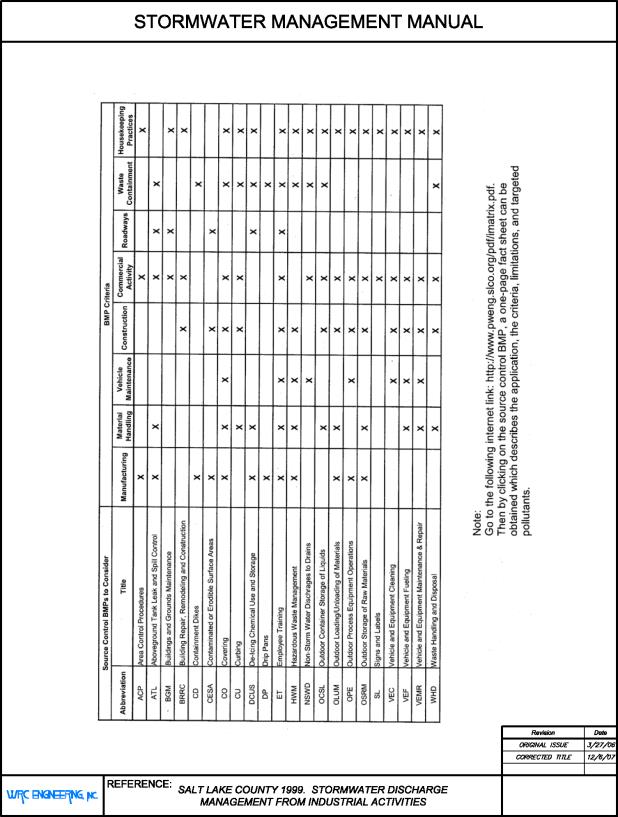
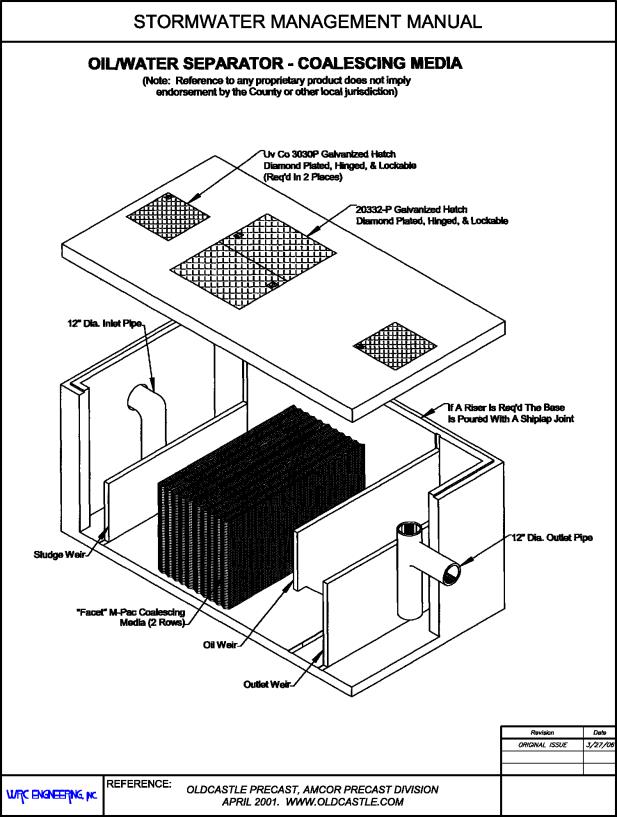
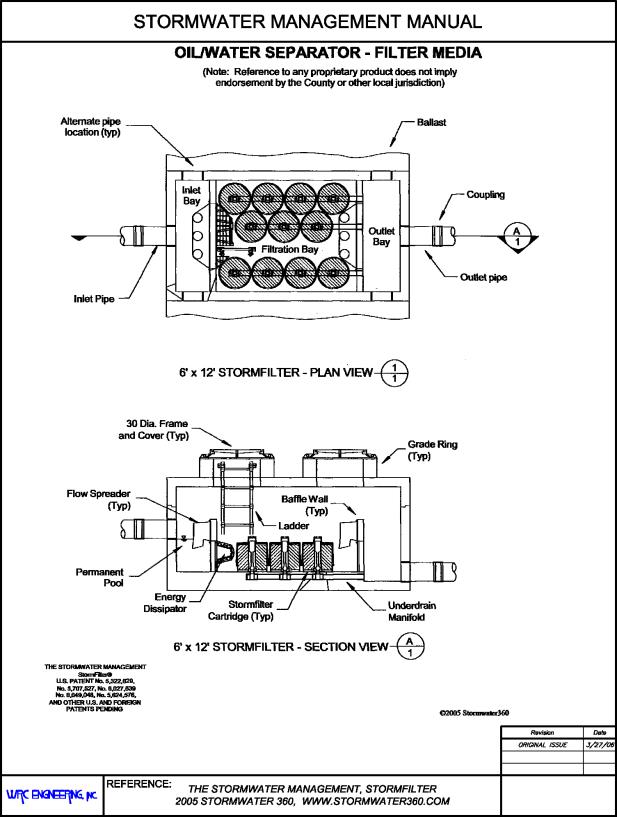
(Res. 40-08 (§ 1607.2), 3-19-08)


